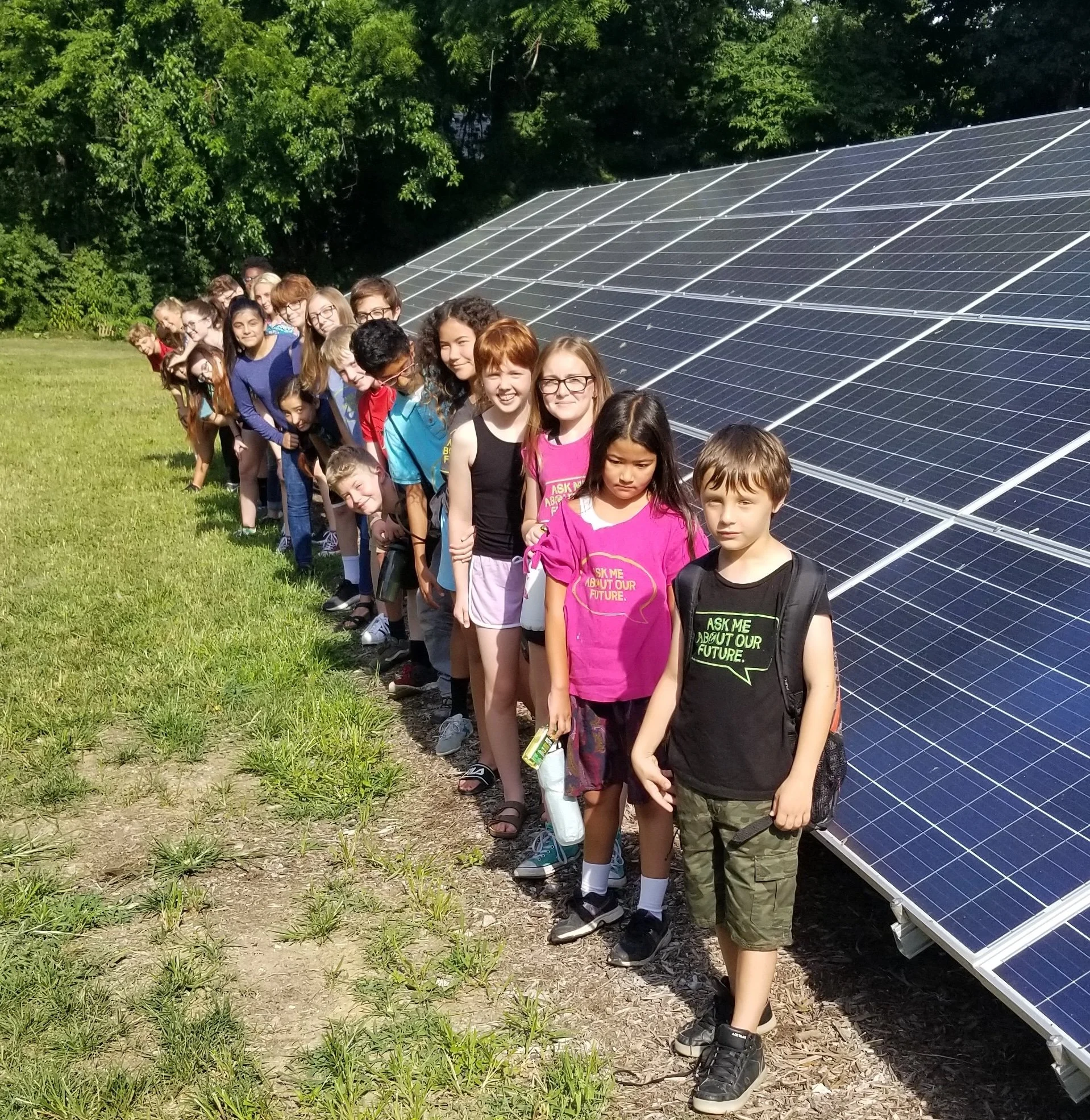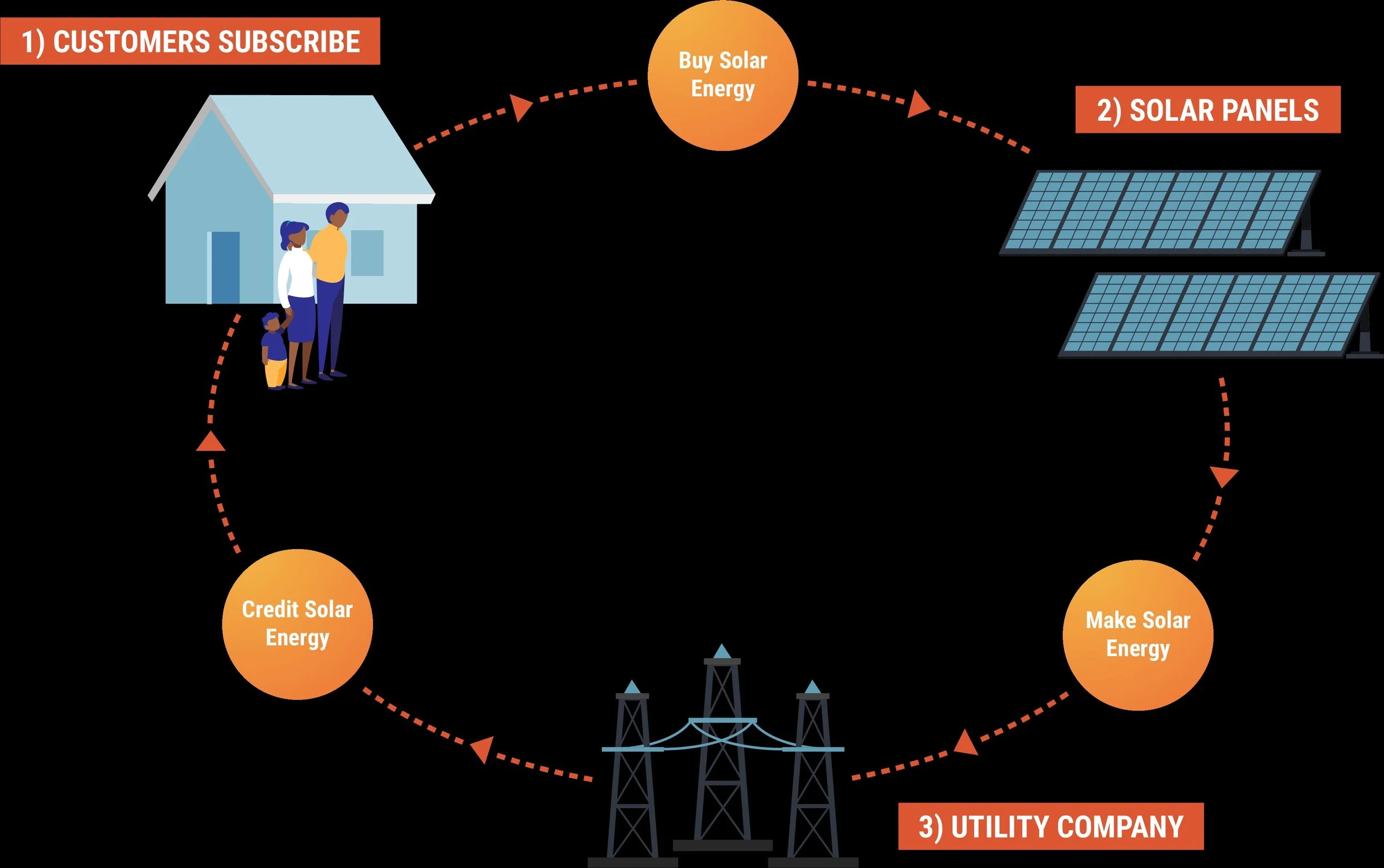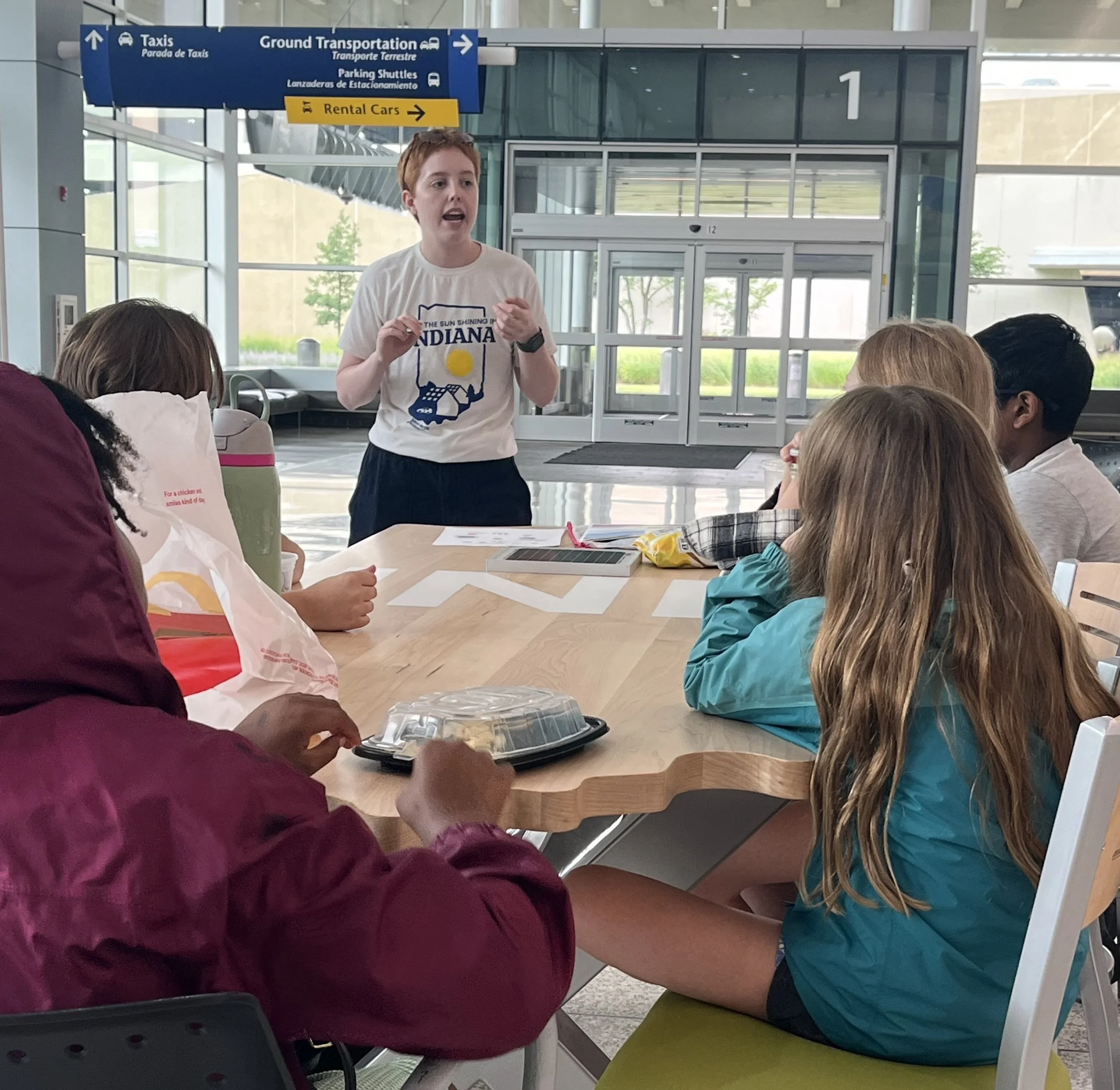Everything You’ve Always Wanted to Know about Community Solar
The author is a rising Sophomore at Indiana University. While it is normally YEPT’s mission to publish middle and high school writers, we occasionally make an exception for college students when the student has past experience with YEPT or our parent organization, Earth Charter Indiana. In this instance, Jamie began working with ECI in 2015, and has continued to in various capacities. Jamie is currently interning with Solar United Neighbors as part of the McKinney Climate Fellows program.
What is Community Solar?
Community solar is a way to make solar and energy savings more accessible for all. Many people want to go solar but are unable to do so due to the configuration of their roof, surrounding tree coverage, their ability to afford the initial investment, or because they don’t own their home. With community solar, customers can subscribe to, or in some cases own, a share of the energy generated by off-site solar panels. Customers then receive a credit on their electric bill for the electricity generated by their portion of the community solar system.
Benefits of Community Solar
Participating in community solar can lower your energy bill by around 10%, according to Solar United Neighbors, while also reducing your carbon footprint. On a larger scale, it benefits the community and the environment by decreasing reliance on fossil fuels and improving the resilience of the electrical grid.
Community solar aims to give back to the community in more ways than just energy. Depending on the project and the level of community involvement, people may have the opportunity to participate in a cooperative that makes decisions on developers, location, and other aspects best aligned with the community's values. Even without a cooperative, many programs aim to use community solar to enrich communities. This includes employing local labor for construction and maintenance. Hoosier Environmental Council cites a study from WorkingNation, which predicts that, over the next 5 years, the demand for green jobs in Indiana will increase by nearly 30%. Community solar is a great way to allow those jobs to support communities directly.
Solar arrays are also a great way to make unused land productive and sustainable. This includes brownfields, rooftops, and farmland that does not yield crops. According to Keith Hevenor, Communication Manager for Nexamp, a national clean energy company, land is typically leased for the duration of a community solar project, around 20-25 years. This benefits local landowners by generating passive income from unused land without having to sell. Often, these are farmers with land that is unusable or unproductive for crop yield. It provides steady, predictable, long-term income that can be used to strengthen family farms, further supporting the community. Each project also has a decommissioning bond associated with it, so that at the end of the lease, if either party decides not to renew, the solar farm can be decommissioned, recycled, and the land is ready for a new life.
Community solar supports people and local businesses at all levels. It empowers communities to take control of their energy production, making affordable, clean energy accessible.
The author, Jamie, learned about solar power from an early age, here pictured (circa 2017), fourth child from the right, with fellow elementary aged students in one of ECI’s summer camps. Provided photo.
What’s a community solar subscription?
In conversations with Keith Hevenor, he walked me through the process that Nexamp and many other community solar companies go through to set up a new community solar program and then allocate that energy to a new subscriber.
Most community solar companies, including Nexamp, operate on a subscription model. However, the phrase “subscription model” can lead to some misunderstanding. Unlike a streaming service or other typical subscriptions, a community solar subscription is not a fixed amount every month; it is variable, depending on the amount of energy used and generated.
Community solar operates in partnership with local utility companies. As energy is generated, it is sent to the grid. The energy generated by the solar arrays is translated into credits, which are applied to the bills of subscribers. Furthermore, there is a fixed discount off the energy bill for participating in community solar (the percentage varies depending on the state). It is most commonly a two-bill system: one from the utility company with the applied credits, and one from the community solar company for the energy, which includes the discount. This can be confusing, but rest assured that it does result in overall savings, and community solar companies are working to consolidate bills to simplify the process.
To set up a subscriber with community solar, a company will review the subscriber's energy usage over the past 12 months and then allocate a portion of the community solar array to cover the subscriber’s electricity needs for the year. Energy usage is looked at on an annual basis to account for the longer summer days and shorter winter days, which result in varying solar energy production. Due to variable energy consumption and production, energy bills and credits will differ every month and should balance out at the end of the year.
This variability may not be suitable for households living paycheck to paycheck. In those instances, programs like Illinois Solar for All, which are geared towards low- to moderate-income customers, offer opportunities to flatten the monthly bill based on estimated energy consumption. This is similar to traditional budget billing with a utility company. At the end of the year, the final bill will be adapted to reflect the actual balance.
Additionally, some local and state governments subsidize companies to offer community solar to low- or moderate-income residents. These savings are passed on to subscribers in the form of a higher discount, further reducing the energy burden and increasing accessibility for solar energy.
It is worth noting that, although much of this process is based on annual data, the program and subscriptions are typically month-to-month. There is usually no enrollment or cancellation fee; however, cancellation may not be immediately available because of the relationship between the community solar company and the utility company. Community solar companies submit a list of customers and the amount of credits that should be allocated to each household to the utility company. If a subscriber wants to cancel, they will be removed from the list. However, utility companies often only accept updated lists at specific times, such as quarterly.
Community ownership is similar, but operates without a community solar company owning the solar arrays. Instead of a community solar company, the arrays are owned by community members, often in a cooperative. According to Diana Eddowes, Director of Community Access for Solar United Neighbors, this approach can allow for more freedom in the decision-making process, but it also requires a significant amount of time and effort. It also allows owners to earn passive income from the excessive energy produced.
Community Solar In Indiana
Federal funding can support community solar projects. In Indiana, where there is currently no legislation that creates a clear path forward for developing community solar projects, federal funding can be critical. One major funding opportunity comes from Solar for All, a $7 billion program from the U.S. Environmental Protection Agency (EPA), supporting 60 grant recipients to expand or establish low-income solar programs. These programs will enable more than 900,000 households in low-income and disadvantaged communities to benefit from distributed solar energy. While federal policy changes have created an environment of uncertainty, as of this writing the Solar for All Program is moving forward.
Hoosiers will benefit from Solar Opportunities Indiana, a $117.4 million Solar for All Program being administered by Indiana Community Action Association, Inc. (IN-CAA) and several other local governments and nonprofits. Two community solar projects receiving funding from Solar Opportunities Indiana are featured below.
Columbus, Indiana
To learn more about the Doug Otto Community Solar Project, I met with Mike Mullett, a member of the Energy Matters Community Coalition, Inc.
The Doug Otto Community Solar Project is a proposed plan where the arrays would be owned by the Doug Otto United Way Center, a community center that provides various social services to low-income communities. Due to legal regulations, at least 50% of the energy generated would need to be sold to Duke Energy, their local utility company, with the rest going to the Doug Otto Center, which would offset their Duke Energy bill.
Mullet says, “As we understand, other people cannot provide energy other than the regulated utilities. With consent from Duke and approval from [the Indiana Utility Regulatory Commission], the Doug Otto subscription to community solar would be lawful.”
Through good faith negotiations and a letter of commitment from Duke Energy, it is proposed that the proceeds from the energy sold to Duke Energy would be used to provide energy to 300-400 low-income households. The proceeds would be deposited into an escrow account at Duke to credit the bills of subscribing low-income customers, which would be an unconventional approach but entirely within Duke’s authority.
This proposed plan would be groundbreaking for community solar in Indiana, paving the way for future investments in communities and clean energy.
Fort Wayne, Indiana
Fort Wayne, Indiana, is also working towards community solar from a municipal standpoint. I spoke with Kerry Korpela about how their upcoming project utilizing community solar will benefit Fort Wayne’s citizens. Korpela is the program manager for the City of Fort Wayne's Climate Action and Adaptation Plan, as well as the Fort Wayne City Utilities Envision Initiative.
To bring relief to those who are most economically disadvantaged and experience steep energy burdens, they are turning to community solar. “Having a community model is crucial when working in an area with older housing stock. Older roof and wiring replacement can be prohibitively expensive when trying to integrate solar,” Korpela explained.
The envisioned project started with the idea of delivering savings directly to people’s electric bills. The solar array would be City-owned and operated as a traditional subscription-based community solar program. “It’s been a complex process, navigating the realities of community solar. We’re working hard to create a model that works for Fort Wayne residents.”
Korpela highlights the necessity of affordable energy in Fort Wayne. Many families can't afford electricity, so they turn on gas stoves and ovens to warm their spaces. Community solar not only fuels homes, but the savings can also fuel families. As Korpela says, “$100 can be the difference between buying your kids food or not.”
Korpela has seen firsthand the excitement that communities have for this endeavor. “I’ve been working with the East Central Neighborhood in Fort Wayne and have seen the way people are excited for a project like this. It gives them hope.”
Savings from community solar can rebuild cities, support families, and create a cleaner future for the next generation.
This summer, the author (above) talked to camp students about community solar — students at around the age when Jamie began learning about solar at camp. The setting of this impromptu “classroom” is the Indianapolis International Airport, which features the largest airport-based solar farm in the world. Note: Jamie and the students traveled to the airport via the IndyGo bus system. Provided photo. (For more YEPT coverage of camps, go here.)
Indiana Needs Community Solar!
Over twenty other states have enacted legislation for community solar, including neighboring states like Illinois and Minnesota as well as traditionally conservative states like Alaska. It’s time for Indiana to join them in building up communities. Indiana is falling behind, and, without action, we risk becoming less competitive in clean energy, one of the largest growing industries.
Hoosier Environmental Council reports that Indiana ranks among the highest states for carbon emissions per capita and ranks #45 in air quality. Community solar helps lower emissions, improving air quality and health, without requiring major infrastructure changes.
SUN’s Director of Community Access, Diana Eddowes, makes an excellent point that Indiana has a significant history of industry and pollution, particularly in the vicinity of the Great Lakes. This damage is directly related to fossil fuels and our current energy system. She believes that community solar is a great way to begin repairing the harms done to those communities.
Eddowes sums it up perfectly: “I think community solar is a no-brainer. It benefits everyone.”
Hoosiers across the state are working toward enabling community solar. Check out these actions provided by Hoosiers for Community Solar and Solar United Neighbors to get involved and tell your legislators to join the fight for accessible, affordable energy!






